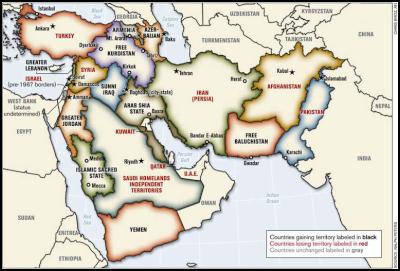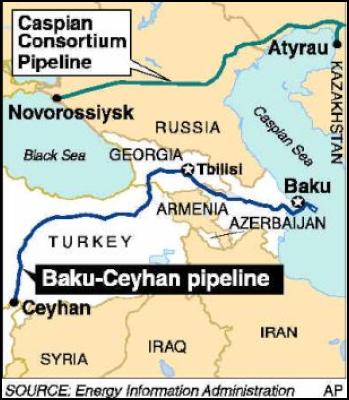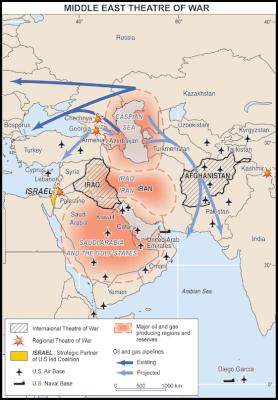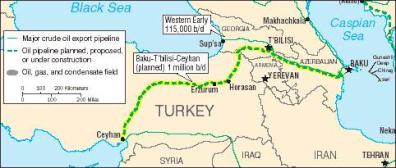The Demonization of Muslims and the Battle for Oil
The "Demonization" of Muslims and the Battle for Oil
by Michel Chossudovsky
Global Research, January 4, 2007
Throughout history, "wars of religion" have served to obscure the economic and strategic interests behind the conquest and invasion of foreign lands. "Wars of religion" were invariably fought with a view to securing control over trading routes and natural resources.
The Crusades extending from the 11th to the 14th Century are often presented by historians as "a continuous series of military-religious expeditions made by European Christians in the hope of wresting the Holy Land from the infidel Turks." The objective of the Crusades, however, had little to do with religion. The Crusades largely consisted, through military action, in challenging the dominion of the Muslim merchant societies, which controlled the Eastern trade routes.
The "Just War" supported the Crusades. War was waged with the support of the Catholic Church, acting as an instrument of religious propaganda and indoctrination, which was used in the enlistment throughout Europe of thousands of peasants, serfs and urban vagabonds.
America's Crusade in Central Asia and the Middle East
In the eyes of public opinion, possessing a "just cause" for waging war is central. A war is said to be Just if it is waged on moral, religious or ethical grounds.
America's Crusade in Central Asia and the Middle East is no exception. The "war on terrorism" purports to defend the American Homeland and protect the "civilized world". It is upheld as a "war of religion", a "clash of civilizations", when in fact the main objective of this war is to secure control and corporate ownership over the region's extensive oil wealth, while also imposing under the helm of the IMF and the World Bank (now under the leadership of Paul Wolfowitz), the privatization of State enterprises and the transfer of the countries' economic assets into the hands of foreign capital. .
The Just War theory upholds war as a "humanitarian operation". It serves to camouflage the real objectives of the military operation, while providing a moral and principled image to the invaders. In its contemporary version, it calls for military intervention on ethical and moral grounds against "rogue states" and "Islamic terrorists", which are threatening the Homeland.
Possessing a "just cause" for waging war is central to the Bush administration's justification for invading and occupying both Afghanistan and Iraq.
Taught in US military academies, a modern-day version of the "Just War" theory has been embodied into US military doctrine. The "war on terrorism" and the notion of "preemption" are predicated on the right to "self defense." They define "when it is permissible to wage war": jus ad bellum.
Jus ad bellum serves to build a consensus within the Armed Forces command structures. It also serves to convince the troops that the enemy is "evil" and that they are fighting for a "just cause". More generally, the Just War theory in its modern day version is an integral part of war propaganda and media disinformation, applied to gain public support for a war agenda.
The Battle for Oil. Demonization of the Enemy
War builds a humanitarian agenda. Throughout history, vilification of the enemy has been applied time and again. The Crusades consisted in demonizing the Turks as infidels and heretics, with a view to justifying military action.
Demonization serves geopolitical and economic objectives. Likewise, the campaign against "Islamic terrorism" (which is supported covertly by US intelligence) supports the conquest of oil wealth. The term "Islamo-fascism," serves to degrade the policies, institutions, values and social fabric of Muslim countries, while also upholding the tenets of "Western democracy" and the "free market" as the only alternative for these countries.
The US led war in the broader Middle East Central Asian region consists in gaining control over more than sixty percent of the world's reserves of oil and natural gas. The Anglo-American oil giants also seek to gain control over oil and gas pipeline routes out of the region. (See table and maps below).
Muslim countries including Saudi Arabia, Iraq, Iran, Kuwait, the United Arab Emirates, Qatar, Yemen, Libya, Nigeria, Algeria, Kazakhstan, Azerbaijan, Malaysia, Indonesia, Brunei, possess between 66.2 and 75.9 percent of total oil reserves, depending on the source and methodology of the estimate. (See table below).
In contrast, the United States of America has barely 2 percent of total oil reserves. Western countries including its major oil producers ( Canada, the US, Norway, the UK, Denmark and Australia) control approximately 4 percent of total oil reserves. (In the alternative estimate of the Oil and Gas Journal which includes Canada's oil sands, this percentage would be of the the order of 16.5%. See table below).
The largest share of the World's oil reserves lies in a region extending (North) from the tip of Yemen to the Caspian sea basin and (East) from the Eastern Mediterranean coastline to the Persian Gulf. This broader Middle East- Central Asian region, which is the theater of the US-led "war on terrorism" encompasses according to the estimates of World Oil, more than sixty percent of the World's oil reserves. (See table below).
Iraq has five times more oil than the United States.
Muslim countries possess at least 16 times more oil than the Western countries.
The major non-Muslim oil reserve countries are Venezuela, Russia, Mexico, China and Brazil. (See table)
Demonization is applied to an enemy, which possesses three quarters of the world's oil reserves. "Axis of evil", "rogue States", "failed nations", "Islamic terrorists": demonization and vilification are the ideological pillars of America's "war on terror". They serve as a casus belli for waging the battle for oil.
The Battle for Oil requires the demonization of those who possess the oil. The enemy is characterized as evil, with a view to justifying military action including the mass killing of civilians. The Middle East Central Asian region is heavily militarized. (See map). The oil fields are encircled: NATO war ships stationed in the Eastern Mediterranean (as part of a UN "peace keeping" operation), US Carrier Strike Groups and Destroyer Squadrons in the Persian Gulf and the Arabian deployed as part of the "war on terrorism".
The ultimate objective, combining military action, covert intelligence operations and war propaganda, is to break down the national fabric and transform sovereign countries into open economic territories, where natural resources can be plundered and confiscated under "free market" supervision. This control also extends to strategic oil and gas pipeline corridors (e.g. Afghanistan).
Demonization is a PSYOP, used to sway public opinion and build a consensus in favor of war. Psychological warfare is directly sponsored by the Pentagon and the US intelligence apparatus. It is not limited to assassinating or executing the rulers of Muslim countries, it extends to entire populations. It also targets Muslims in Western Europe and North America. It purports to break national consciousness and the ability to resist the invader. It denigrates Islam. It creates social divisions. It is intended to divide national societies and ultimately trigger "civil war". While it creates an environment which facilitates the outright appropriation of the countries' resources, at the same time, it potentially backlashes, creates a new national consciousness, develops inter-ethnic solidarity, brings people together in confronting the invaders.
It is worth noting that the triggering of sectarian divisions and "civil wars" is contemplated in the process of redrawing of the map of the Middle East, where countries are slated to be broken up and transformed into territories. The map of the New Middle East, although not official, has been used by the US National War Academy. It was recently published in the Armed Forces Journal (June 2006). In this map, nation states are broken up, international borders are redefined along sectarian-ethnic lines, broadly in accordance with the interests of the Anglo-American oil giants (See Map below). The map has also been used in a training program at NATO's Defense College for senior military officers.
MAP OF THE NEW MIDDLE EAST

Note: The above map was prepared by Lieutenant-Colonel Ralph Peters. It was published in the Armed Forces Journal in June 2006, Peters is a retired colonel of the U.S. National War Academy. (Map Copyright Lieutenant-Colonel Ralph Peters 2006).
Click for big version
The Oil Lies in Muslim Lands
The oil lies in Muslim lands. Vilification of the enemy is part and parcel of Eurasia energy geopolitics. It is a direct function of the geographic distribution of the World's oil and gas reserves. If the oil were in countries occupied predominantly by Buddhists or Hindus, one would expect that US foreign policy would be directed against Buddhists and Hindus, who would also be the object of vilification..
In the Middle East war theater, Iran and Syria, which are part of the "axis of evil", are the next targets according to official US statements.
US sponsored "civil wars" have also been conducted in several other strategic oil and gas regions including Nigeria, the Sudan, Colombia, Somalia, Yemen, Angola, not to mention Chechnya and several republics of the former Soviet Union. Ongoing US sponsored "civil wars", which often include the channelling of covert support to paramilitary groups, have been triggered in the Darfur region of Sudan as well as in Somalia, Darfur possesses extensive oil reserves. In Somalia, lucrative concessions have already been granted to four Anglo-American oil giants.
"According to documents obtained by The Times, nearly two-thirds of Somalia was allocated to the American oil giants Conoco, Amoco [now part of BP], Chevron and Phillips in the final years before Somalia's pro-U.S. President Mohamed Siad Barre was overthrown and the nation plunged into chaos in January, 1991. Industry sources said the companies holding the rights to the most promising concessions are hoping that the Bush Administration's decision to send U.S. troops to safeguard aid shipments to Somalia will also help protect their multimillion-dollar investments there." (America's Interests in Somalia, Global Research, 2002)
Globalization and the Conquest of the World's Energy Resources
The collective demonization of Muslims, including the vilification of Islam, applied Worldwide, constitutes at the ideological level, an instrument of conquest of the World's energy resources. It is part of the broader economic, political mechanisms underlying the New World Order.
Oil Reserves by Country
(Proven reserves in billions of barrels)
| Rank | Country | Percent of World Reserves | World Oil, December 2004 | Percent of World Reserves | Oil & Gas Journal, January 2006 |
|---|---|---|---|---|---|
| 1. | Saudi Arabia | 24.2 | 262.1 | 20.6 | 266.8 |
| 2. | Canada* | 0.4 | 4.7 | 13.8 |
178.8 |
| 3. | Iran | 12.1 | 130.8 | 10.3 | 132.5 |
| 4. | Iraq | 10.6 | 115.0 | 8.9 | 115.0 |
| 5. | Kuwait | 9.2 | 99.7 | 7.9 | 101.5 |
| 6. | United Arab Emirates | 6.5 | 69.9 | 7.6 | 97.8 |
| 7. | Venezuela* | 4.8 | 52.4 | 6.1 |
79.7 |
| 8. | Russia |
6.2 | 67.1 |
4.6 | 60.0 |
| 9. | Libya | 3.2 | 33.6 | 3.0 | 39.1 |
| 10. | Nigeria | 3.4 | 36.6 | 2.7 | 35.9 |
| 11. | United States |
2.0 | 21.4 | 1.7 |
21.4 |
| 12. | China |
1.4 | 15.4 |
1.4 | 18.3 |
| 13. | Qatar | 1.8 | 20 | 1.2 | 15.2 |
| 14. | Mexico |
1.4 | 14.8 |
1.0 | 12.9 |
| 15. | Algeria | 1.4 | 15.3 | 0.9 | 11.4 |
| 16. | Brazil |
1.0 | 11.2 |
0.9 | 11.2 |
| 17. | Kazakhstan | 0.8 | 9.0 | 0.7 | 9.0 |
| 18. | Norway | 0.9 | 9.9 | 0.6 |
7.7 |
| 19. | Azerbaijan | 0.6 | 7.0 | 0.5 | 7.0 |
| 20. | India | 0.5 | 4.9 | 0.4 |
5.8 |
| 21 | Oman | 0.4. |
4.8 | 0.4 | 5.5 |
| 22 | Angola | 0.8. |
9.0 | 0.4 |
5.4 |
| 23 | Ecuador | 0.5 | 5.5 | 0.4 |
4.6 |
| 24 | Indonesia | 0.5 | 5.3 | 0.3 | 4.3 |
| 25 | UK | 0.4 | 3.9 | 0.3 |
4.0 |
| 26 | Yemen | 0.3 | 3.0 | 0.3 | 4.0 |
| 27 | Egypt | 0.3 | 3.6 | 0.3 | 3.7 |
| 28 | Malaysia | 0.3 | 3.0 | 0.2 | 3.0 |
| 29 | Gabon | 0.2 | 2.2 | 0.2 |
2.5 |
| 30 | Syria | 0.2 | 2.3 | 0.2 | 2.5 |
| 31 | Argentina | 0.2 | 2.3 | 0.2 |
2.3 |
| 32 | Equatorial Guinea |
0.2 | 1,8 | 0.0 |
0.0 |
| 32 | Colombia | 0.1 | 1.5 | 0.1 |
1.5 |
| 33 | Vietnam | 0.1 | 1,3 |
| 0.6 |
| 34 | Chad | 0.0 | 0.0 | 0.1 | 1.5 |
| 35 | Australia | 0.3 | 3.6 | 0.1 |
1.4 |
| 36 | Brunei | 0.1 | 1.1 | 0.1 | 1.4 |
| 37 | Denmark | 0.1 | 1.3 | 0.1 |
1.3 |
| 38 | Peru |
0.1 | 0.9 | 0.1 | 1.0 |
| Total Muslim Countries** | 75.9 | 822.1 | 66.2 | 855.6 | |
| Total Western World (EU, North America, Australia) | 4.1 |
44.8 | 16.5 |
213.3 | |
| Other Countries | 20.6 | 214.9 | 17.3 | 223.6 | |
| World Total | 100.0 | 1,081.8 | 100.0 | 1,292.5 | |
Source: EIO: Energy Information Administration (Scroll down for explanatory notes on the table)
© Map by Eric Waddell, Global Research, 2003.

For details on the Campaign
against the pipeline see
http://www.bakuceyhan.org.uk/more_info/bp_pipeline.htm
Image Source – Wikipedia
NOTES PERTAINING TO THE TABLE ON THE DISTRIBUTION OF OIL RESERVESIndicated are the world's main oil reserve countries. Countries with less than 0.1 % of total reserves are not indicated.
The Oil and Gas Journal figures indicated above are based on proven oil reserves including the bituminous oil fields (oil sands or tar sands). The World Oil figures indicate oil reserves without the tar sands. The difference between the two sets of figures largely pertains to the position of Canada and Venezuela. The tar-sands are considered by some experts as not recoverable with present technology and prices, although this issue is the object of heated debate.
Muslim countries are indicated in bold. Percentages are rounded up to first decimal.
*Canada appears according to this estimate as the Second Country in terms of the size of proven reserves, due to the size of its bituminous oil fields. The Oil & Gas Journal's oil reserve estimate above for Canada includes 4.7 billion barrels of conventional crude oil and condensate reserves and 174.1 billion barrels of oil sands reserves.
In other recognized estimates, where the oil sands are not accounted for, Canada's reserves are much lower (in billions of barrels):
BP Statistical Review 16.802
Oil & Gas Journal 178.792
World Oil 4.700
BP notes that "the figure for Canadian oil reserves includes an official estimate of Canadian oil sands "under active development"." BP says of its data sources for oil reserves that "the estimates in this table have been compiled using a combination of primary official sources, third-party data from the OPEC Secretariat, World Oil, Oil & Gas Journal and an independent estimate of Russian reserves based on information in the public domain.
World Oil's Canadian oil reserve estimate "does not include 174 billion bbl [barrels] of oil sands reserves."
READ MORE Articles by Michel Chossudovsky
Disclaimer: The views expressed in this article are the sole responsibility of the author and do not necessarily reflect those of the Centre for Research on Globalization.
To become a Member of Global Research
The CRG grants permission to cross-post original Global Research articles on community internet sites as long as the text & title are not modified. The source and the author's copyright must be displayed. For publication of Global Research articles in print or other forms including commercial internet sites, contact: crgeditor@yahoo.com
For media inquiries: crgeditor@yahoo.com
© Copyright Michel Chossudovsky,
Global Research,
2007




 Eugene Doyle: The Fall Of Saigon 1975 - Fifty Years Of Repeating What Was Forgotten
Eugene Doyle: The Fall Of Saigon 1975 - Fifty Years Of Repeating What Was Forgotten Peter Dunne: Dunne's Weekly - Trump's Tariffs Still Pose Risks For New Zealand
Peter Dunne: Dunne's Weekly - Trump's Tariffs Still Pose Risks For New Zealand Keith Rankin: Barbecued Hamburgers And Churchill's Bestie
Keith Rankin: Barbecued Hamburgers And Churchill's Bestie Gordon Campbell: On Why The US Stands To Lose The Tariff Wars
Gordon Campbell: On Why The US Stands To Lose The Tariff Wars Eugene Doyle: Before It’s Too Late - Reimagine New Zealand’s Military Future
Eugene Doyle: Before It’s Too Late - Reimagine New Zealand’s Military Future  Binoy Kampmark: Gender Stunts In Space - Blue Origin’s Female Celebrity Envoys
Binoy Kampmark: Gender Stunts In Space - Blue Origin’s Female Celebrity Envoys